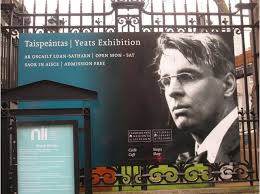
On the 29th October 2013, some enthusiastic sixth year English students, with a keen interest in poetry and culture, made the trip to The National Library of Dublin.
Here at the library located on Kildare Street next to Dáil Eireann, the students visited the fantastic exhibition of the life and works of the poet and playwright William Butler Yeats.
The award winning exhibition was first opened to the public in 2006, with the intent of being open for a single year only. Nine years on, the excellent exhibition is still as popular as ever with visitors of Irish nationality and for foreign tourists.
We were welcomed into the exhibition by our friendly and helpful tour guide, organised to assist us throughout. On first step into the exhibition room, we saw the poetic works of Yeats brought to life visually, as the poems were read aloud to changing images which one could sit and enjoy.
The exhibition was organised in a way that captured the changing times within Yeats’ life.
First we saw protected heirlooms from Yeats’ childhood, including a school report and pictures of his childhood home and surrounding area, which he later captures and refers to in his escapist era of poetry. This was followed by a glimpse into his teenage years, where we see him explore some more complex issues in attempt to gain understanding about the world around him and indeed himself.
The next section of the exhibition focused on the women within Yeats’ life and the role they played in his works as a playwright and poet. This particular room had framed photographs of different mistresses and love interests of Yeats, from Countess Markievicz and Maud Gonne to his own wife, Georgiana Hyde-Lees. This was interesting to see the total amount of women and how crucial their involvement with Yeats was in such ways to which they influenced his writings.
Following this we saw Yeats’ special connection to the older Lady Gregory, who Yeats was very close to in having similar interests with artistic and cultural projects, the major one being the setting up of The Abbey Theatre.
In glass cases were original letters Yeats and Gregory wrote to each other and it was clear to see the exceptional bond they held. Yeats in middle age explored different cults and religions. The exhibition portrayed this graphically with detailed robes and symbols from different cults and religions Yeats became fixated on. It was interesting to see how this influenced his works, bringing forth new ideas of self expression in a slightly romanticised fashion.
From the exhibition it was clear to see how Yeats was heavily involved and interested in politics. From his poems ‘Easter 1916’ and ‘September 1913’ Yeats comes forth holding his own stance as a well established poet in society at the time, as he notes his reactions and views to these national social and political events which he lived through.
In later life he furthered his political input becoming a member of the Seanad. His objective as a Seanad member was to be a representative for the area of arts and literature, although he often ignored this and got involved in heated controversial debates on topics such as divorce. Within his final years of life he was still a persistent poet and won the Nobel Prize for Literature. At the exhibition, the top hat which he wore when receiving the award was on display and also a replica of the award itself.
In the final back room within the exhibition there was a place to sit to watch a film playing of literary and public figures speaking about Yeats, the late poet Seamus Heaney featured speaking here which was great to see their own appreciation of Yeats. The exhibition had an excellent mixture of factual information, social history, politics, romance and religion which gave a detailed look into these aspects of Yeats’ life and works.
All artefacts present were donated by Yeats’ family, and it was really a capsule of dedication to the great poet and playwright he was and so much more. The mixture of multimedia modern technologies alongside original manuscripts was great to see, as the original works of Yeats were brought into focus to modern access.
To take the virtual tour online visit www.nli.ie/yeats .
The Yeats exhibition is just one of many free attractions to visit in Dublin. For those who wish to discover more about the attractions within our cultural capital city, log on to http://www.dublin.ie or www.visitdublin.com .